Aphids are common in the majority of gardens. These soft-bodied insects are small and suck the nutrients from plants. When they attack plants in large numbers, they weaken the plants, harming fruits and flowers. This insect multiplies at a rapid rate, which is why you need to be able to identify them and control them before they start reproducing.
They are slow movers and with the right care, you can control them easily. The problem is that they are so small, they are difficult to see with the naked eye. They are pear-shaped with long antennae.
Table of Contents
Types of Black Aphids
The most common black aphids you may have infesting your indoor or outdoor plants include:
1. Melon Aphid
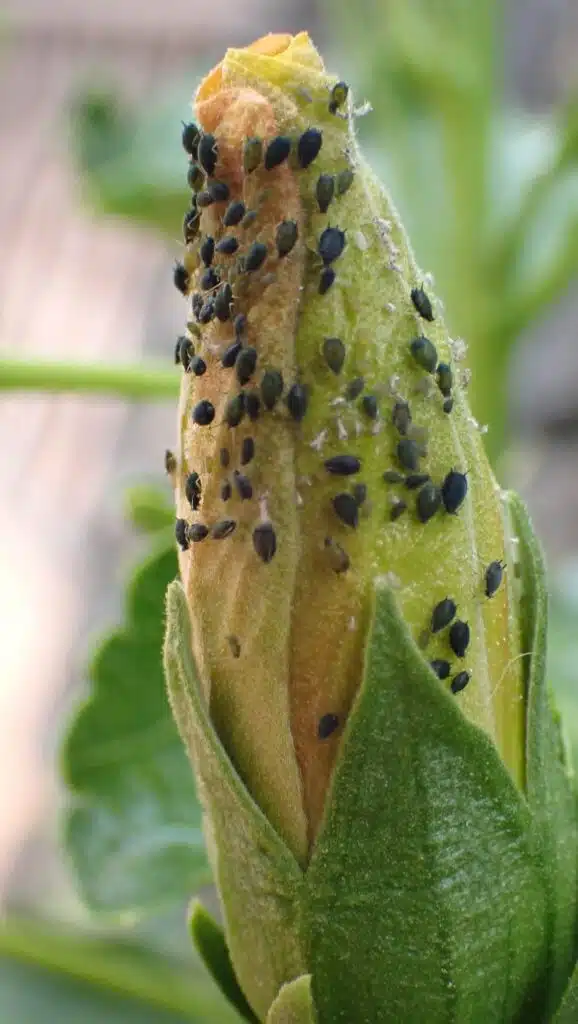
The Melon Aphid (Aphis gossypii) is found in tropical regions throughout the world. They are not common in northern areas. They are common pests in the southwest and southeast of the United States. They tend to overwinter in greenhouses and can be transferred to fields with transplants.
Female nymphs in the north hatch in the spring on the primary host plant. They will feed as they mature. In some cases, they produce winged females, which can disperse to secondary hosts, forming new colonies. The female deposits yellow eggs on the host plant.
In the south, the female produces offspring without mating, as she feeds and grows. They are not affected by heat and can complete development and reproduce within a week.
These black aphids are around 2mm in length and are usually wingless. Its body can vary in color from dark green mottled in light green to black. They have black cornicles. Winged females grow to 1.7mm in length with a black head and thorax. The abdomen is yellow-green.
The adult’s reproduction period is approximately fifteen days. The optimal temperature for reproduction is between twenty-one and twenty-seven degrees. Females produce up to eighty offspring at around four per day.
These aphid hosts a wide range of plants. There are sixty host plants known in Florida alone and approximately seven hundred host plants around the world. It is a major pest on cucumber, squash, pumpkin, and watermelon.
2. Cowpea Aphid
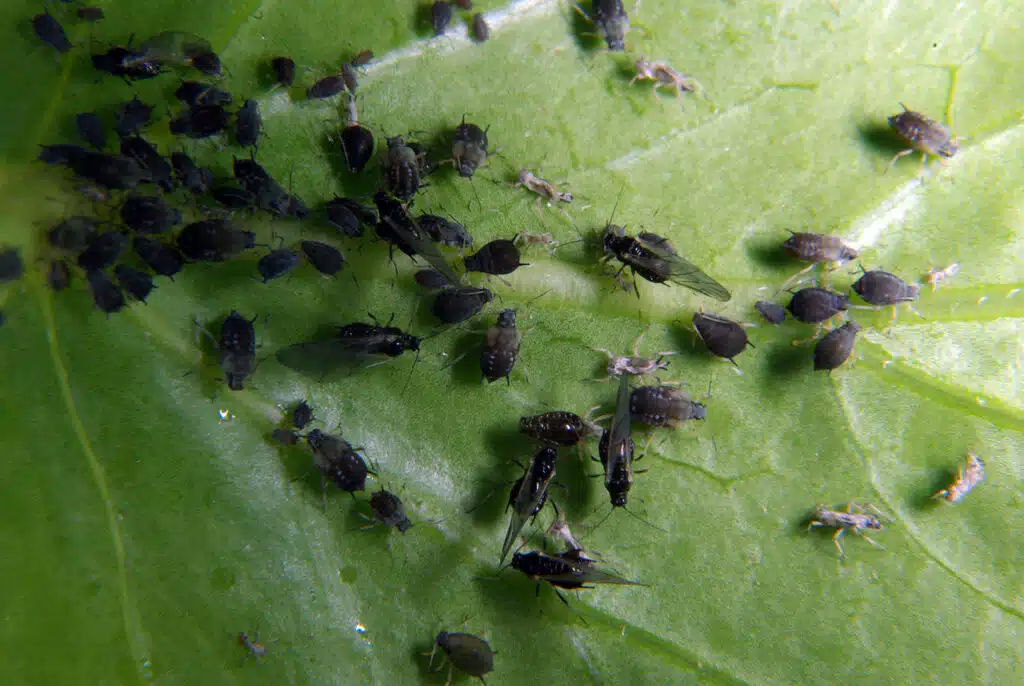
The Cowpea Aphid (Aphis craccivora), also known as the black legume aphid or groundnut aphid, belongs to the Aphididae family and is a common invasive species. This is a very small aphid.
The female is glossy dark brown or black with a tail-like protrusion. The legs are yellow or brown. The antennae, are long, comprising six segments. Winged females can grow to 2.2mm in length, while the wingless female is slightly smaller.
This is a cosmopolitan species and can extend its range to Canada, Siberia, Chile, and Argentina. They are common in the Mediterranean, India, Philippines, Thailand, Africa, Latin America, and the southern United States.
This black aphid feeds on numerous host plants with a preference for the bean family. They are common pests for beetroot, cotton, cowpeas, cardamom, chickpea, and peanut crops.
3. Giant Willow Aphid
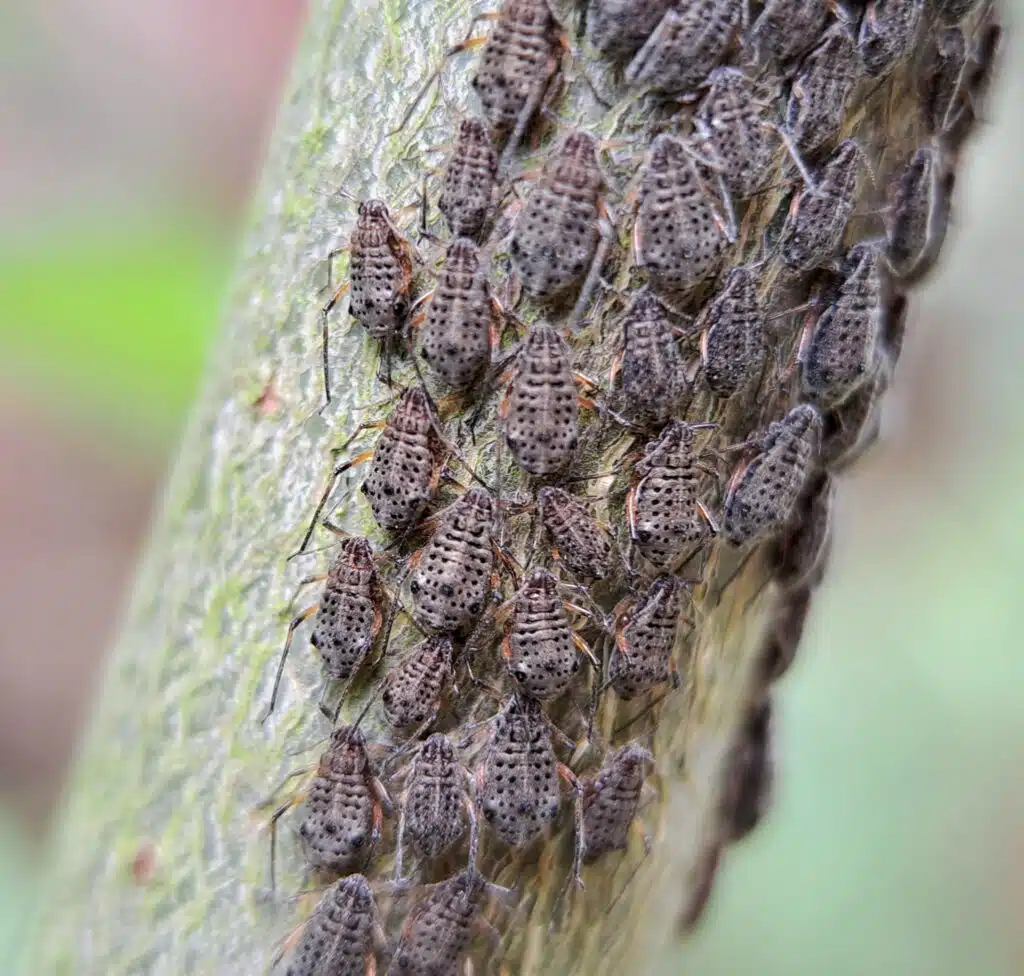
The Giant Willow Aphid (Tuberolachnus salignus) belongs to the Tuberolachnus genus and can grow to 5.8mm in length. They are one of the largest black aphids you may encounter and were first described in 1790.
They are increasing in numbers, commonly found on commercially grown willows. It is believed that they originated in Europe and have been introduced around the world. They are common pests in Australia and New Zealand since 2013.
The wingless giant willow aphid can grow to 5,8mm in length and are dark brown with black patches. The body, which is covered in hair, has a gray-gold sheen. The antennae are half the body length.
The winged giant willow aphid has dark brown wings that they rub together, releasing a red stain. The winged individuals give birth to around thirty-four nymphs.
4. Giant Bark Aphid
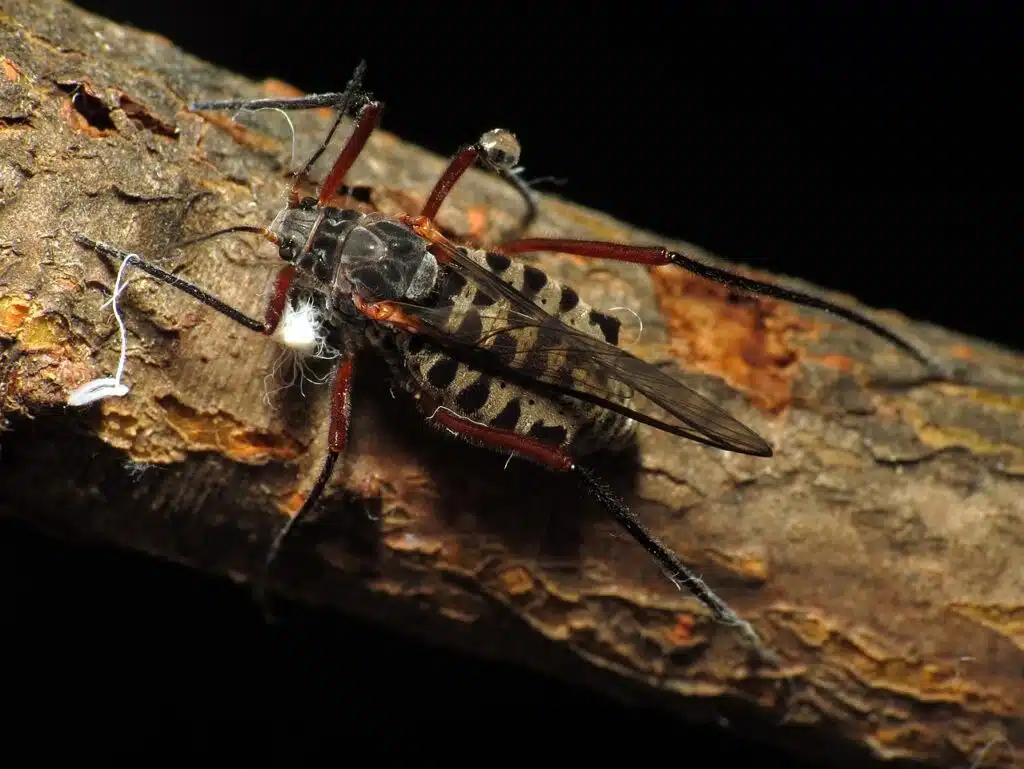
The Giant Bark Aphid (Longistigma caryae) is the largest aphid, common in North Carolina. The wingless individuals are light gray with black spots down the back. They can increase their populations at an exceptionally fast rate.
Some nymphs develop into winged adults, enabling them to fly to new locations. The wings are gray. The females lay eggs on hardwood twigs. Eggs hatch in the spring.
This is the largest aphid species in North America. Adults can grow to 6mm in length. They are brown with black spots and a blue-gray wax secretion. This is a winged species, but egg-laying females are wingless.
They occur throughout the United States, including Alabama, Arizona, Delaware, California, Florida, Iowa, Georgia, Mississippi, Texas, Virginia, and South Carolina. They are common on deciduous trees.
This aphid causes serious damage. In heavy infestations, they sap feed and cause leaf discoloration, dead twigs, and branches. They produce a clear sticky liquid, called honeydew, which causes damage to outdoor furniture and cars.
Promoting tree health is the best control measure against these black aphids. They feed in large populations in the spring and insecticides sometimes work before the infestation becomes fully established.
5. Black Bean Aphid
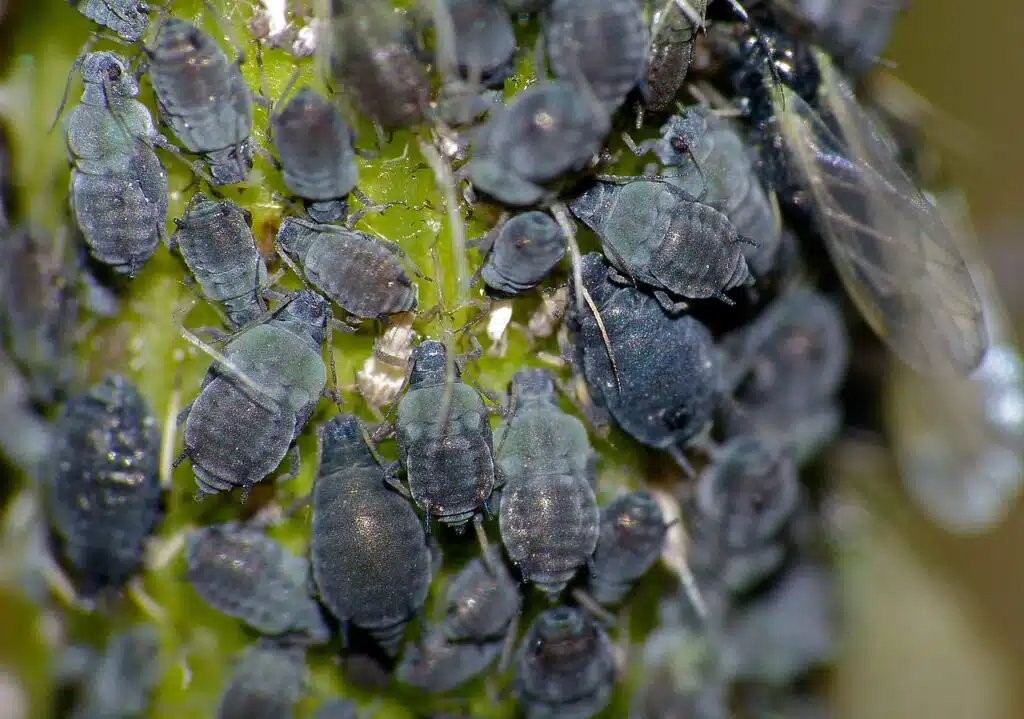
The Black Bean Aphid (Aphis fabae) is a small aphid with a soft body. It belongs to the Hemiptera order. It is also known as the black fly or beet leaf aphid. They are found in large numbers under the leaf of host plants in warmer months. There are winged and wingless variants of this pest.
This species sucks the sap from the leaves and stems of host plants, causing stunted growth, reducing yield, distorting shoots, and spoiling crops. It also spreads viruses, causing plant disease. The honeydew they secrete encourages mold growth.
Ants feed on the black bean aphid’s honeydew. They are widely distributed and during the fall, they move to different host plants. The black bean aphid is black and grows to 3mm in length.
It is a serious pest to sugar, beans, and beets. They cause damage through feeding. Eggs hatch in early spring, forming colonies on young shoots and leaves. The winged form appears in May and June. They have been recorded on more than three hundred plant species. They can transmit more than thirty plant diseases.
6. Smoky Poplar Aphid
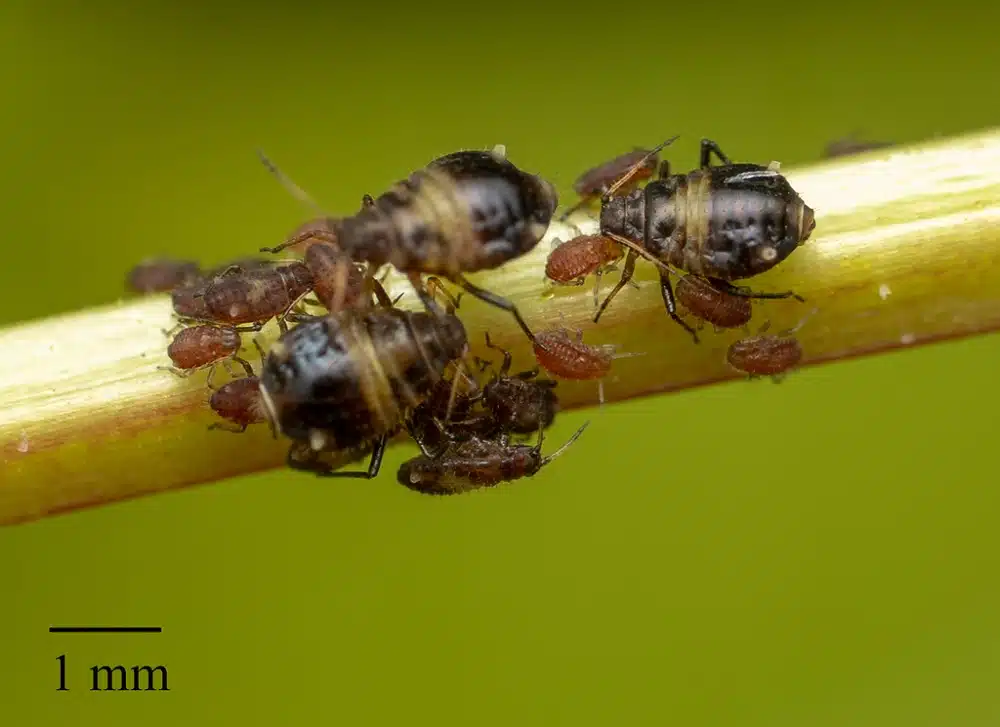
This aphid (Chaitophorus populicola) is shiny black or yellow-brown with long antennae. There is hair on the abdominal tergites. The hair is tapered to points. The legs are black to dark brown. Winged individuals have black marks on clear wings.
This species feeds on poplars and aspen. They feed on plant juice, which is filled with sugar and amino acids. They create a honeydew, that is exceptionally sticky, attracting other insects, including ants. They feed in colonies and are gregarious.
They are found on the newly developed leaves of a tree. You will find them on the upper leaf surface or the short shoots. They are usually found with ants, that are feeding off the honeydew they produce.
7. Hedgehog Grain Aphid
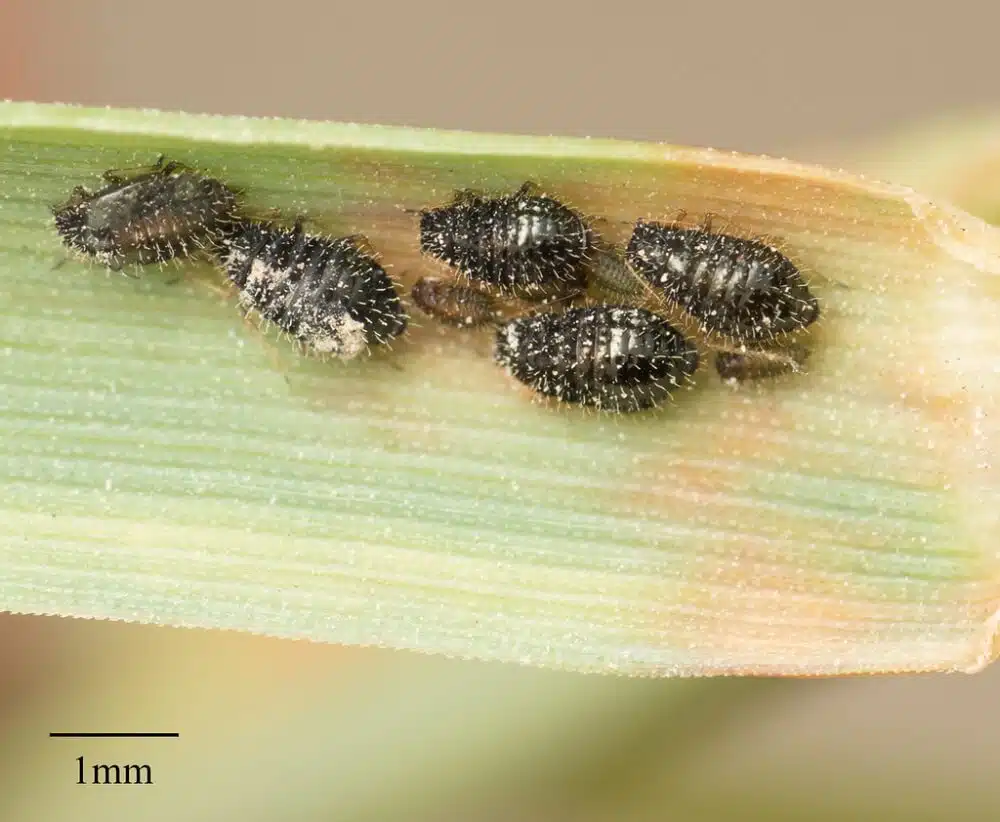
The Hedgehog Grain Aphid (Sipha maydis) is an invasive pest that affects cereals and grass. It is a new pest, first reported in 2007. They are common in the Mediterranean areas, including South Africa, South Asia, and Central Asia. They have also been introduced to the United States on imported plants.
They have a slow pace of dispersion. This aphid is black with a hardened abdomen. It feeds on grass hosts, which include barley, corn, and oats. It has been recorded on over thirty cereal plants and grass species.
The hedgehog grain aphid causes damage to the leaves of the host plant. It feeds on the upper surface of the leaf, close to the base. They are also known to feed on the stems. When there is a large infestation, the leaves will become yellow and roll.
8. Waterlily Aphid
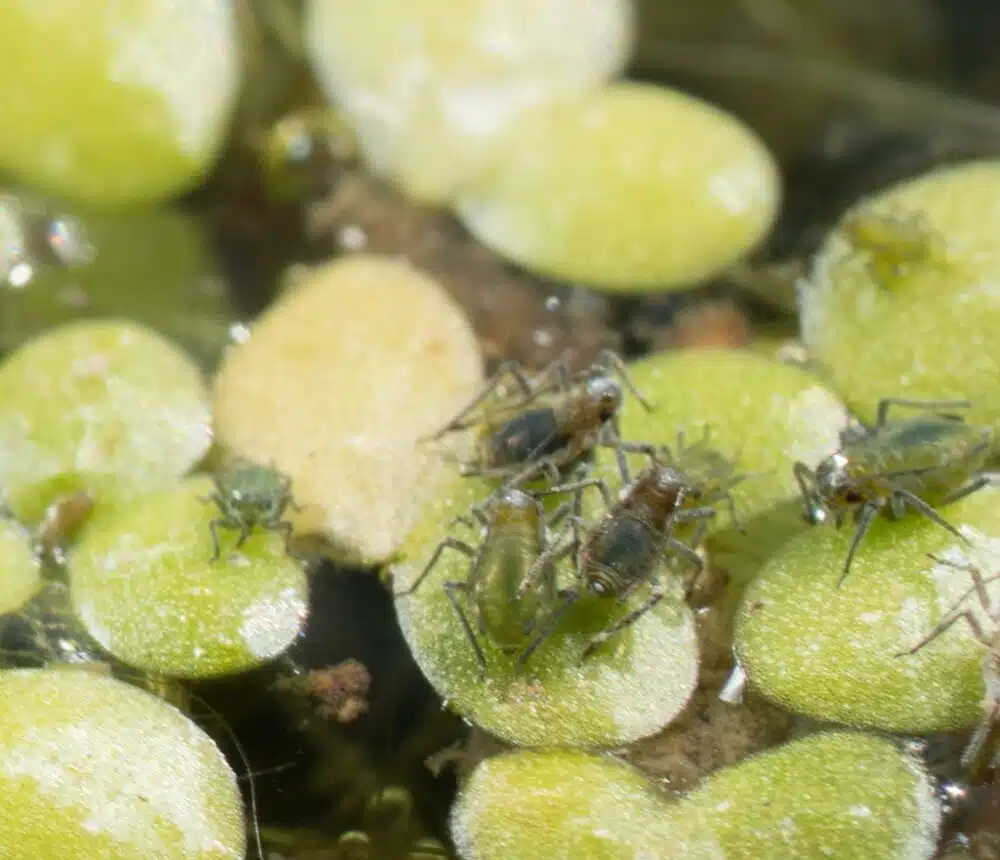
The Waterlily Aphid (Rhopalosiphum nymphaeae) can grow to 2.5mm in length. This aphid is a dark red-brown or green. It causes considerable damage to host plants by sucking the sap from the flower buds and the upper surface of the leaves. It prefers waterlilies but will feed on other aquatic plants.
The plant damage caused often only happens in summer. This is due to the large colonies that develop. Large colonies develop on waterlilies, mostly on the flowers and leaves. The best temperature for breeding is between twenty-one and twenty-seven degrees. They can double their population size every two days, growing populations quickly.
9. Elder Aphid
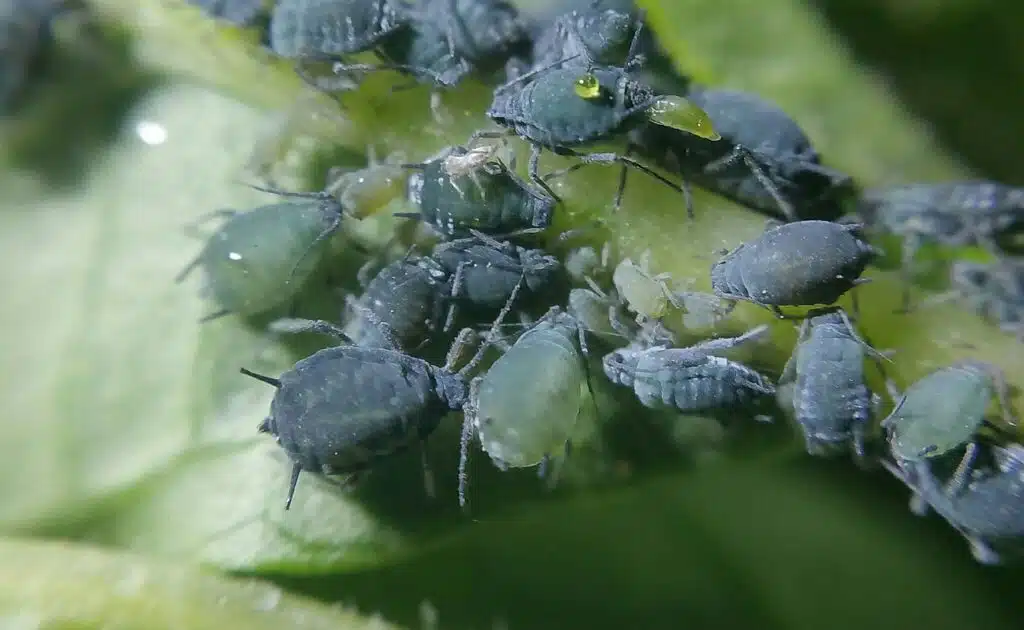
The Elder Aphid (Aphis sambuci) is a dark aphid, usually green or yellow-brown. The adults sometimes have a white strip on the side of the abdominal segments. The antennae are black and long. This aphid can grow to 3.5mm in length.
This aphid forms large colonies on elders in the springtime. They also host on the roots of various herbs, including docks and campions. The overwintering eggs hatch in the spring, which increases the colonies on elders.
Winged females can be found throughout summer. The wings enable them to disperse and increase the risk of infestation. This aphid is well-adapted to the urban environment. They are found on young shoots on roadsides and car parks. When in large colonies, they attract predators, which include ladybirds.
10. Bird Cherry-oat Aphid
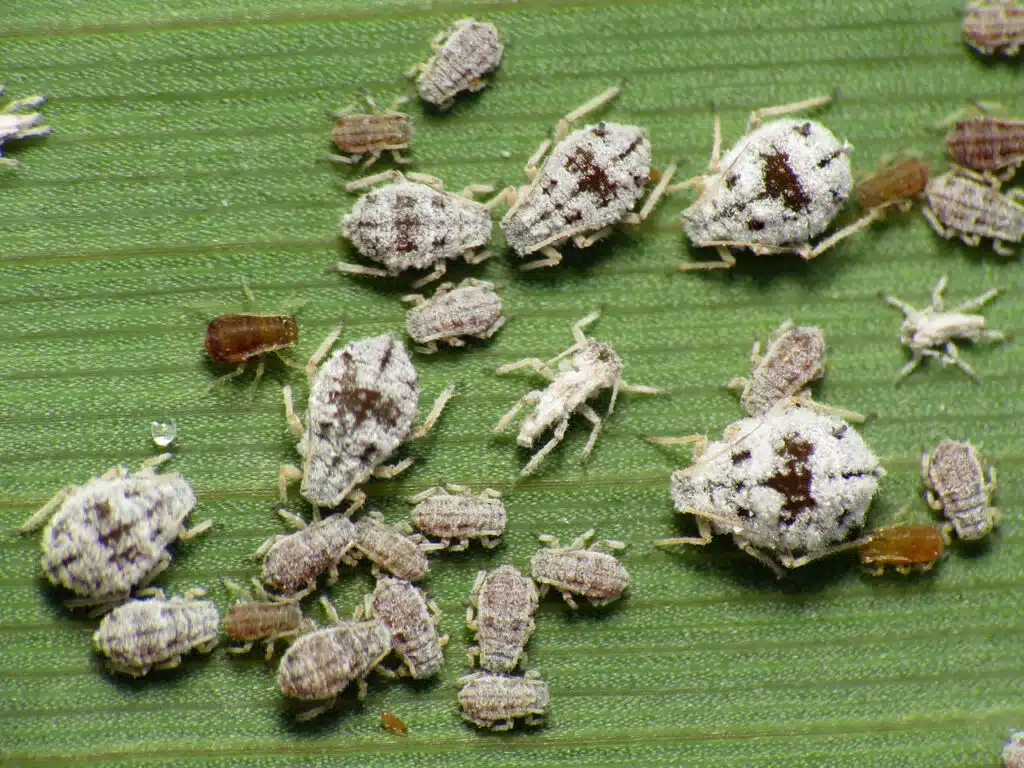
This aphid (Rhopalosiphum padi) belongs to the Aphidoidea family. It is a true bug that sucks the sap from plants. It is a major pest in cereal crops in temperate areas. It transmits several plant viruses. It is found throughout the world, colonizing in large numbers on host plants.
In the springtime, they are known to attack cereal and pasture grasses, which include oats, barley, and wheat. They are also found in maize plants. They are known for transferring barley yellow dwarf virus, maize leaf fleck virus, and rice giallume virus.
11. Plum-thistle Aphid
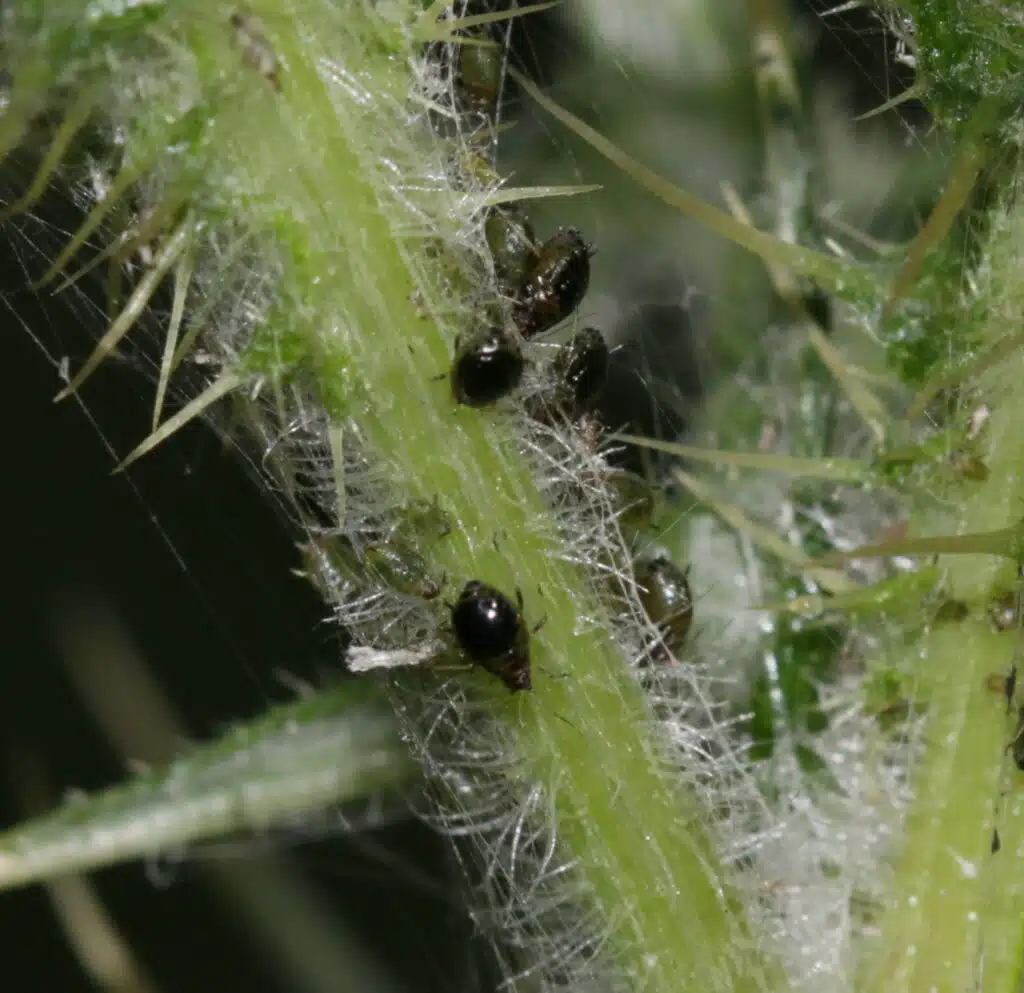
The Plum-thistle Aphid (Brachycaudus cardui) infests trees in the Prunus genus. They infest trees during spring and autumn, choosing aster family plants during summer. Wingless females are oval-shaped and can grow to 2.5mm in length. They range from dark brown to yellow and green to red. The abdomen is dark.
The nymphs have pink batches on a green background. This species is distributed throughout Asia, Europe, North Africa, and North America. The primary host of the plum-thistle aphid is cherry, plum, damson, apricot, and peach. They move to a secondary host during summer.
The colonies usually have ants with them. The ants feed on the honeydew produced by the aphids. When dealing with an infestation of this aphid, plant leaves roll up. The aphid can transfer plant diseases, including plum pox to plumbs, peaches, damsons, apricots, and other plants.
12. Bicolored Frostweed Aphid
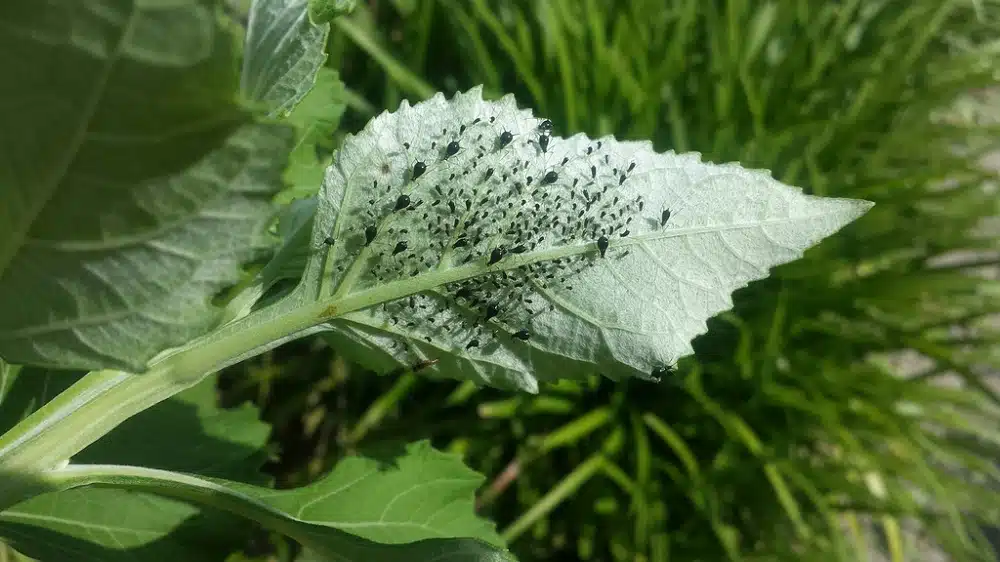
The Bicolored Frostweed Aphid (Uroleucon verbesinae) is a shiny black aphid with long antennae. The femora base is pale yellow with black tarsi. It has dark dorsal hairs. Immature aphids are red or red-brown. They are also shiny.
They feed predominantly on frostweed in the United States but have been recorded to feed on Verbesina in Honduras. They feed under the leaf before moving to the stem of the host plant.
This pest aphid is common in the southern United States, including Florida, Texas, Louisiana, and Arkansas.
13. Onion Aphid
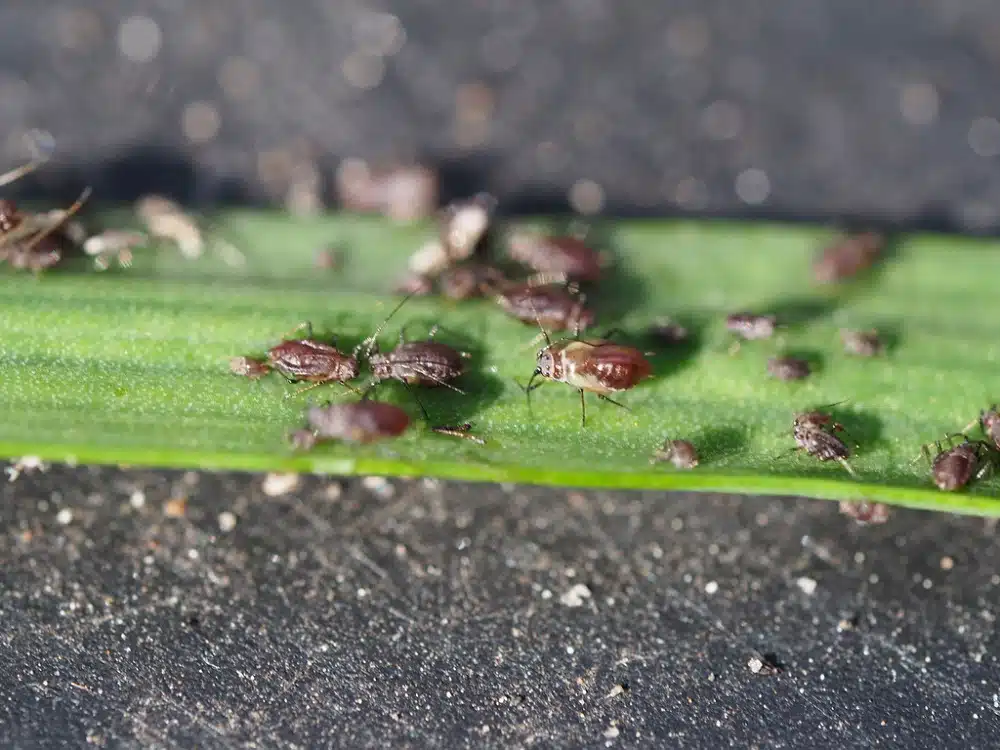
The Onion Aphid (Neotoxoptera formosana) belongs to the Aphidoidea superfamily in the Hemiptera order. Today they can be found throughout the world.
This dark-colored aphid is red-brown and hosts a variety of plants. They carry plant disease, causing serious damage to plants. As adults, they are shiny magenta, red-brown, or black. The antennae are black and they grow to 2.3mm in body length.
Winged individuals are dark red or black with black-bordered wings. The wing borders on the veins are the same width as the veins, widening at the base. This aphid does not alternate hosts. It will spend its entire life on an onion plant, either on the bulbs or leaves.
This species also does not have sexual forms. They reproduce parthenogenetically throughout the year. They are native to southeast and east Asia and have invaded Southern America, North America, Europe, Australia, and New Zealand.
The onion aphid was first discovered in France in 1984. It is regularly observed in low numbers throughout European countries. They were introduced to the Netherlands in 1994, where they were found in glasshouses with onion plants being heavily infested.
It was then reported in Britain in 1999. They were able to eradicate the pest, but it was found again in 2000, having overwintered in a garlic clove. The frequency of observations has increased considerably over the years and they are now well-established and widespread throughout Britain.
Black Aphid Damage
Black aphids are problematic for indoor plants, outdoor plants, and crops. They can multiply ten times a week and a plant can become infested in the blink of an eye. They occur throughout the year, causing plants to weaken with distorted foliage, disease, and disfigured flowers.
Black aphids also transmit disease. The aphid produces honeydew, which is a sugared substance that becomes a black sooty mold. Many aphids are resistant to insecticides, making it exceptionally difficult to get rid of them, especially at the rate they multiply.
They cause serious economic damage due to their feeding damage, which is direct damage. The indirect damage is the viruses that they spread. The infestation will usually start with young plants, but soon spread all over the plant. With some females being winged and able to fly, they can disperse to other host plants, forming colonies in gardens, greenhouses, and crops.
The adults and nymphs suck nutrients from the host plants, which disturbs the plant’s growth hormones. This retards the growth of the plants, increasing the risk of deformed leaves. When the infestation starts early in the season, they can kill young plants. Defoliation and retarded growth reduce the yield of crops considerably.
The plant sap has a low protein content but is overflowing with sugars. As a result, the aphid needs to suck large amounts of sap to get the proteins that they need. The honeydew they produce causes fruits and crops to become sticky. The black molds that grow on the honeydew, contaminate ornamental crops and fruits.
Overall, they can cause considerable damage. They are often found on indoor and outdoor plants and have caused the considerable economic loss in crop yields over the years. The fact their populations can increase quickly means if you don’t catch them early, you will struggle to eradicate them successfully.
Attempts to eradicate the aphids have sometimes been successful, but they have been found on the same crops a short while later.
How to Get Rid of Black Aphids on Plants
The majority of black aphids are immune to common insecticides, which makes them very difficult to get rid of. There are some signs and symptoms to look out for on your indoor and outdoor plants to identify if your plants are suffering from an aphid infestation.
In some cases, you can see the aphid colony with your naked eye. They tend to colonize on flower buds, under young leaves, and on the shoot tips. The leaves may become curled or distorted. Aphids weaken the plant.
Another thing to look for if you are unsure if you have an aphid infestation is to look for their honeydew on host plants, which will be a black sticky substance, sometimes accompanied by ants.
In addition to this, you may find that there is a black or brown powder, which can be found on the upper leaf surface. This is called sooty mold., which grows on the honeydew the aphids produce. The sooty mold. is the easiest way to determine if you have an aphid infestation.
Ants are also tell-tale signs that you have aphids. Ants will climb on the plants where aphid colonies are located. They are attracted to the sugary and sticky honeydew. Ants also remove the predators of aphids, helping them continue to multiply.
If you have seen a plant in your garden or in your home that has aphid damage, then you will want to try the following:
- Spray the aphid-infested plants with a powerful stream of water. The blast of water is sometimes effective in dislodging them from the plant. This also makes it harder for the aphid to find its way back to the same plant.
- In some cases a spray bottle with water mixed with a few drops of dish soap is effective. Spray the leaves of the plant with the solution and wipe the aphids away. This should be reapplied every two days for up to two weeks.
- Insecticide soaps, horticultural oils, and neem oil are also sometimes effective against aphids. These products must come into contact with the aphid colony to be effective. Follow the instructions on the packaging and handle it with care.
- Mix water, dish liquid, and cayenne pepper and spray the plants. The mixture should include a quart of water, one teaspoon of dish soap, and a pinch of cayenne pepper. It should not be diluted before you spray it on the plant.